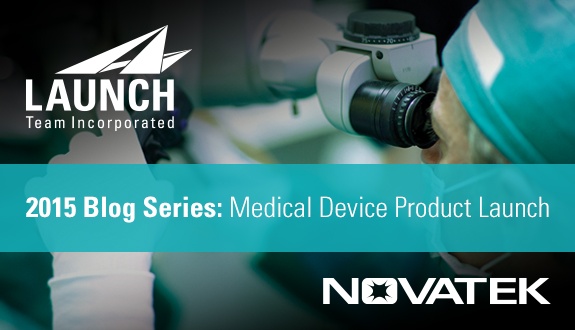 Michele Nichols, President of Launch Team, Inc., and Amy Castronova, President of Novatek Communications, Inc., are teaming up again this fall to bring you the latest in product launch, technical documentation, training, and marketing trends in medical device and manufacturing. In a series of blog posts, we’ll share industry and economic trends, emerging regulatory and business challenges, and best practices for overcoming those barriers to new product launch and adoption.
Michele Nichols, President of Launch Team, Inc., and Amy Castronova, President of Novatek Communications, Inc., are teaming up again this fall to bring you the latest in product launch, technical documentation, training, and marketing trends in medical device and manufacturing. In a series of blog posts, we’ll share industry and economic trends, emerging regulatory and business challenges, and best practices for overcoming those barriers to new product launch and adoption.
In the 2014 Ernst and Young annual medical technology report, Pulse of the industry, Glen Giovannetti, EY's Global Life Sciences Leader, said:
“As purchasing decisions become increasingly centralized and influence shifts from physicians to hospital administrators and managers, the historical value drivers for purchasing a device — brand, quality and design — will lessen, leaving price as a main consideration. To achieve meaningful differentiation for their offerings, firms will need to design and market their products in ways that demonstrably improve patient outcomes while also lowering costs.”
Fast forward a year and the topic most presented and discussed during Medtech conference season is value-based healthcare and its implications. Healthcare trends such as changing reimbursement models, consolidation, and pressure to cut costs and improve outcomes are influencing purchasers to select medical devices primarily on price unless there is clearly differentiated ability to improve outcomes and/or lower health care costs.
So how do you differentiate your company from competitors?
Consider usability. Usability is the measure of how useful, usable, and satisfying a device or system is for the intended user to perform prescribed tasks to achieve a goal. While measuring the influence of usability on a system is challenging due to numerous healthcare audiences and varying requirements, I would argue that product usability factors – simplicity, naturalness, consistency, forgiveness, feedback, effective use of language, and effective information presentation – can improve the experience with a device and therefore improve patient outcomes. When use of a device, system, or process is clear, intuitive, and easy, people are more apt to use it and use it properly.
Usability Techniques for Differentiating in a Commoditized Environment
Design to Value
Success in the new healthcare environment requires a deep understanding of patient, physician, surgeon, purchasing, and payer needs and perceptions. Simply removing a device feature may reduce cost and appeal to purchasers, but ultimately increase the lifetime cost of care or be perceived as ineffective to patients. Device capabilities must match the stakeholders’ perception of value and how much they’re willing to pay for them. Align your product positioning with stakeholders’ perception of value, design to value, and deliver on the brand promise.
Plan for Patient Compliance
The success of many devices relies on the patient’s reaction to the device or ability to use it as directed. For consumer products, it is especially critical that the design, training, and instructions make it easy and intuitive for the patient to use. When patients don’t comply, results are skewed and the perceived value of the device is diminished. Prevent patient ignorance, misunderstanding, and confusion with clear instructions, training, or online tutorials for future reference.
Carefully Design Implementation
Even if a device is considered extremely user friendly, the implementation is equally responsible for determining end user acceptance and effective use. Human factors engineering research has shown that the approach to device implementation needs to be designed carefully if benefits are to be realized. Training and participation are key to effective implementation. A well designed training program can accomplish both by transferring knowledge and skills to users to properly use the device as well as, invite the users to participate in the implementation. For example, a Train-the-Trainer program. Competence and involvement increase acceptance.
In last week’s Medtech Trends and Challenges podcast, Amy and Michele discussed commoditization and why it is critical to shift customer perception through differentiation.
Check back for our next post in this series, where we will further discuss medical device product launch and differentiation. Until then, download our Positioning Guide to learn more about the benefits of differentiation.


